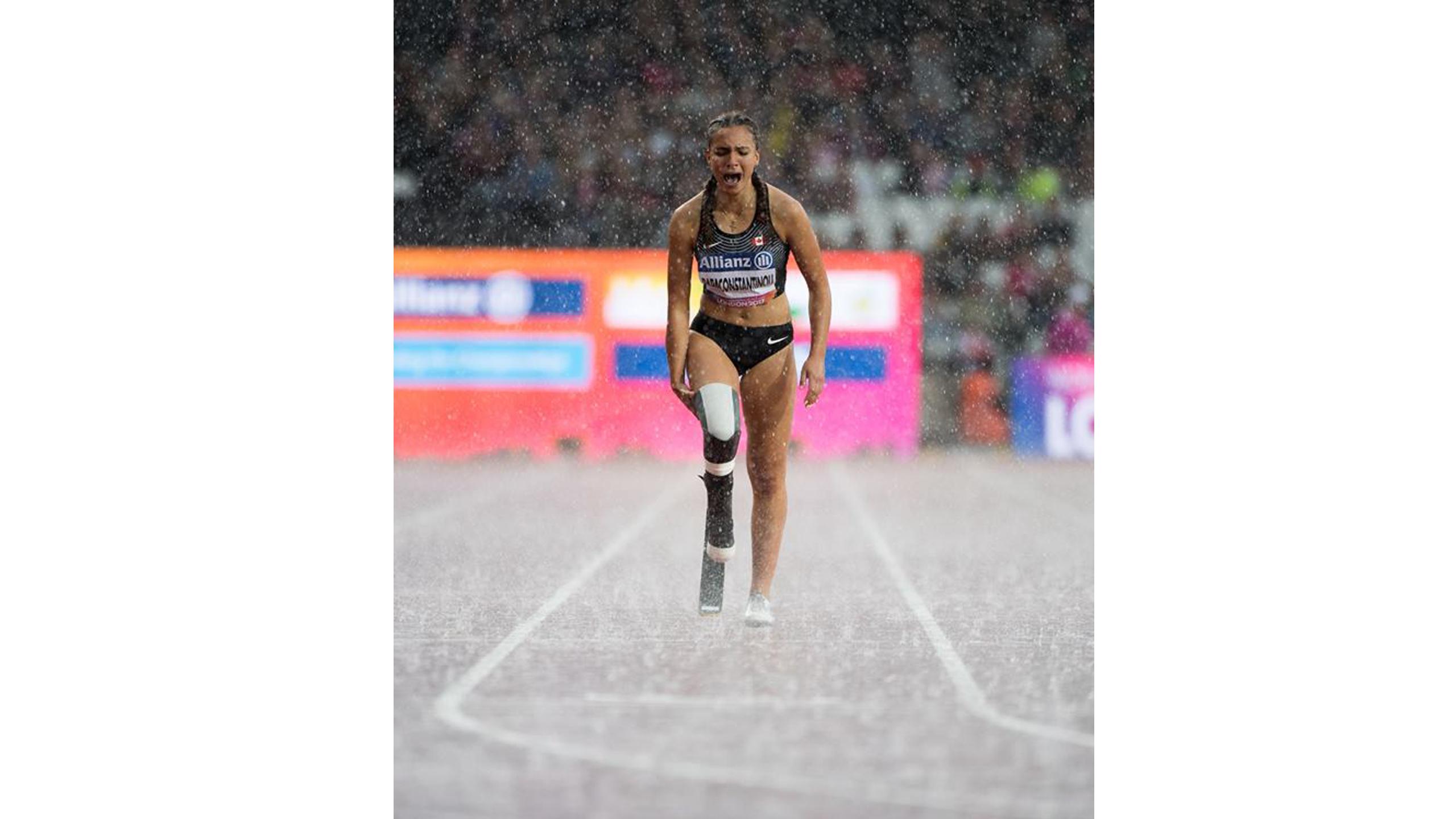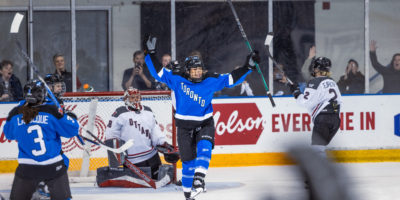By Matt Vocino
Spectators watched as heavy rain poured at the Olympic Stadium in London. Marissa Papaconstantinou stood in lane three, all smiles as she waved to the camera and crowd. She was introduced to the world before the end of the 2017 200m T44 World Para Athletics Championships.
Moments later, the 17-year-old Papaconstantinou would come out of the blocks flying, racing down the red coloured track, approaching the final straight. She was putting herself in a position to get on the podium.
But as the finish line appeared in sight, Papaconstantinou felt her hamstring pop. She managed to take a few more laboured strides before falling to her knees. The smile that was on her face a minute earlier was gone. Instead, it was replaced by a look of pain and disappointment.
Born without her right foot, the now-RTA sport media student began participating in team sports at a young age and would run whenever she could.
While in elementary school, her passion and interest in track and field would grow. She attended high school running meets with her dad, a high school principal, on a regular basis. “My [Dad] would always take me to track meets to watch him run,” recounts Papaconstantinou. “It was always part of my life.”
While running was a constant part of Papaconstantinou’s life growing up, she didn’t pursue the sport that she loved to watch until the age of 11 when she received her first running blade.
Unlike a traditional prosthesis, a running blade is much lighter and springier, which in turn reduces impact pressure, allowing individuals to run more comfortably and, of course, faster.
“The first time I ran on it was on a treadmill to test it out, and I just remember [thinking], ‘Wow, this is really cool.’ I don’t feel the same sort of pain I felt before. It felt freeing,” says Papaconstantinou.
Since trying on the blade for the first time many years ago, Papaconstantinou hasn’t looked back. At the age of 12, she was selected by Athletics Canada and was invited to Ottawa for a “Para Camp” to be evaluated—exposing herself to other disabled athletes for the first time.
“I was always the only person that I had known with a disability,” says Papaconstantinou, who says she became more comfortable with herself after the event. “I realized that there are more people out there like me that sometimes maybe go through similar struggles, or have had similar experiences.”
“I don’t feel the same sort of pain I felt before. It felt freeing”
In 2014, the Ontario Science Centre created an exhibit inspired by Papaconstantinou that promotes bionics and prosthetics in “human performance.”
A year later, at 15, Papaconstantinou served as the Pan Am torchbearer that carried the flame when the torch relay visited the Science Centre.
And only a few months later, the 15-year-old set a Canadian record for her amputee class in the 200m at her first Para Worlds, setting her up for a spot in the Rio Games and a potential chance at the Paralympics.
This was huge, especially because at one point, Papaconstantinou says she didn’t even know about the Paralympics.
Although unsure if she would be selected for the Rio Games because she was only 17, her dream became a reality as Canada’s rising star made her debut on the Paralympic stage in Brazil. She finished ninth in the 100m, but was disqualified from the 200m for stepping on the line.
The disqualification was a tough pill to swallow as it was one of her best races. “I just remember my pure reaction of, ‘Oh my God I really messed up’ and that’s just something that is keeping me pushing forward.”
The adversity prepared her to battle through her injury. Just a month and a half after the popping of her hamstring at the 2017 World Para Athletics Championships, she began university at Ryerson in the RTA sport media program and began training with the Toronto Varsity Blues. She had to get used to a new routine, a new coach and a new school while trying to make new friends.
“It was a tricky time,” says Bob Westman, Papaconstantinou’s coach.
Westman, who’s also an assistant track and field coach at the University of Toronto, said that they wanted to be as patient as possible when dealing with the injury and spend time becoming familiar with each other.
“We mostly just wanted to rehab off that injury, let her adjust and transition into being a university student at Ryerson and then start to get to know each other.”
The pop Papaconstantinou felt in her hamstring was a tear. But before it put an end to her season, she got up off the track and finished the race to a cheering crowd.
Looking back on those first five months after the injury, Papaconstantinou admits that it was a challenging time but her drive to accomplish her goals in the future kept her going.
“It was really tough mentally, physically to get over those hurdles,” she says. “Even when I started running again, I would get scared sometimes. And something that always made me feel really good…didn’t really necessarily bring that same joy, but thinking about how close I was, and thinking about what could be possible in the future is what really kept me going.”
Although it would be fair to assume that this would be a huge setback and one of the lowest points of someone’s athletic career, it wouldn’t be the case for Papaconstantinou. Instead, it became a moment she is proud of. She says it painted a picture of the type of person that she is.
“It was really tough mentally, physically to get over those hurdles. Even when I started running again, I would get scared sometimes”
“I don’t even know why I did it, it probably did more harm than good to my body,” she says, “but I think that people realized that even though you get knocked down, you can just get back up and keep moving forward.“
As anyone who has dealt with a serious injury knows, the recovery process is gruelling. Now, 19 months since the injury, a year since returning to competition and in her second year of university, she’s determined to excel in track and field. She now has her sights set on Tokyo 2020.
Although she’s balancing both her studies at Ryerson and a rigorous training schedule, Westman says that Papaconstantinou’s “focus” and drive has given her success.
“You’re going to have hurdles put in front of you, you’re going to have obstacles in the road in the pathway to success, and it’s just her ability to remain calm under pressure, to look for solutions, and about not feeling sorry for yourself,” says Westman. “To just stay driven and focused on the goal, despite whatever setbacks might come, are what are going to lead her to being successful.”
With Tokyo only 18 months away and the negativity and injuries in her rear-view mirror, Papaconstantinou only has three things on her mind: completing her final school project by next year, medaling at the 2019 Para World Championships this November and winning her first medal at the Paralympic Games.
There is no doubt that the lead-up and journey to Tokyo will be a taxing one, and that achieving her goals will be difficult. But if anyone can overcome the hurdles, it’s Papaconstantinou. After all, she’s proven that she has the will and the mental toughness to overcome adversity and achieve her objectives.











Leave a Reply